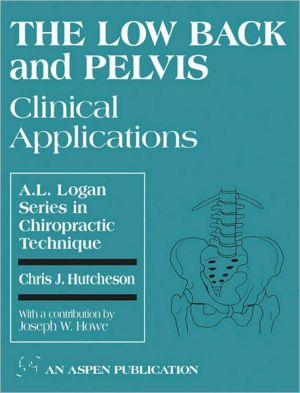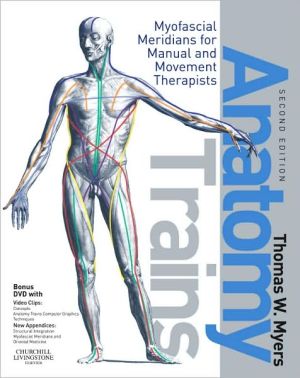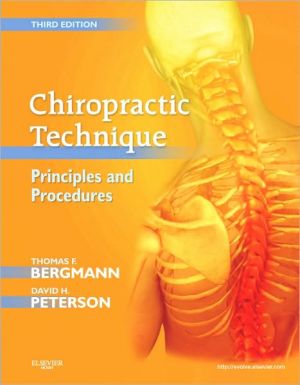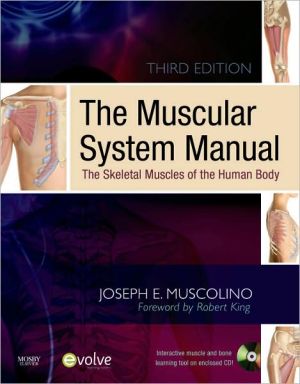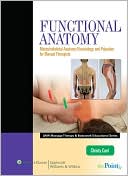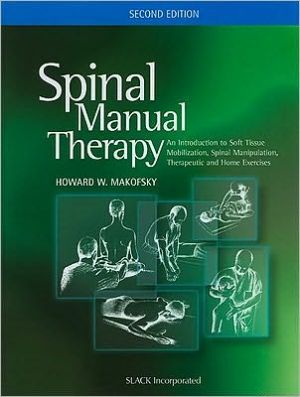The Low Back and Pelvis: Clinical Applications
DisciplineID: 2000\ \ The book contains black-and-white illustrations.\
Search in google:
The Low Back and Pelvis is the third volume in the series of technique manuals featuring chiropractic techniques of the late A.L. Logan, DC. To be used by students and practitioners, this book presents and effective approaches to treatment of the low back and pelvis. Case histories, examination and adjustive techniques, exercises, and numerous illustrations are included. Dana J. Lawrence This book is designed to present the clinical chiropractic procedures and concepts of the late Dr. A. L. Logan as they relate to the low back and pelvis. It is the third in a series of texts that cover the teachings of Dr. Logan; the first two covered the knee, foot, and ankle. It is predominantly a teaching manual, and therefore covers the anatomy of the region, examination, imaging for the low back, muscle testing, adjustive techniques, conditions affecting the low back, exercise and physical therapy, and organic problems that may affect the low back. The purpose is to provide a model for assessing the low back and pelvis as it was originally developed and advocated by Dr. A. L. Logan. It therefore discusses diagnostic and clinical skills that the student chiropractor ought to learn and that will allow for effective management of low back and pelvic conditions. Primarily for chiropractic students, it would also be of interest to practicing chiropractors, osteopaths, and physical therapists. There are a large number of radiographs published throughout the text, and these are of good quality. In some cases, though, identifying information has been left on the films, and this should be deleted in future editions. There are also a large number of line drawings that illustrate the therapeutic techniques, and these are generally of fairly poor quality and pedagogic value. There are insufficient references in this text, except in the chapter on imaging the low back. This seems to have its best value as a teaching manual to be used within the chiropractic laboratory. It is generally rather basic in its presentation, although it has an excellent chapter on imaging the low back. It alsowill be best be used in those chiropractic colleges where the concepts of Dr. Logan are part of the curriculum, so not every college will end up requiring this text. Overall, it does an average job of presenting its concepts, and although not an essential purchase, it may be a good supplemental text for students and doctors.
Series PrefacePrefaceAcknowledgmentsCh. 1Anatomy1Boney Structures1Muscles10Vascular Anatomy16Neuroanatomy17Visceral Anatomy19Functional Anatomy19Ch. 2Examination35Observation35History35Examination36Ch. 3Imaging the Low Back63Imaging Methods63Spinography66Anomalies and Normal Variants70Fractures and Dislocations75Spondylolysis and Spondylolisthesis80Degenerative Spinal Disease82Inflammatory Spinal Disease88Deposition Diseases Involving the Spinal Column92Diseases Causing Osteopenia in the Lower Spinal Column95Tumors and Tumor-Like Conditions of Bone97Significant Incidental Findings117Ch. 4Muscle Testing123Muscle Examination124Ch. 5Adjustive Techniques135Diversified Technique136Principles of Effective Adjustment137Ch. 6Conditions and Treatment149Inflammation and Connective Tissue149Strain/Sprain Injuries151Lordotic Lumbar Syndrome152Leg Length Inequality (LLI)157The Unstable Pelvis159Sciatica161Quadratus Lumborum162Arthritic Lumbosacral Spine163Hip Conditions163Ch. 7Exercises167Abdominals167Gluteus Maximus168Gluteus Medius169Lateral Hip Rotators169Quadratus Lumborum170Transversus Perinci170Lower Q-L and Coccygeal Fibers of the Gluteus Maximus171Fifth Segment of the Psoas171Hip and Waist Exercises172Lordotic Lumbar Exercise172Appendix AOrganic Problems and the Low Back175Appendix BPhysical Therapeutics181Index183
\ From The CriticsReviewer: Dana J Lawrence, DC, MMedEd, MA(Palmer College of Chiropractic)\ Description: This book is designed to present the clinical chiropractic procedures and concepts of the late Dr. A. L. Logan as they relate to the low back and pelvis. It is the third in a series of texts that cover the teachings of Dr. Logan; the first two covered the knee, foot, and ankle. It is predominantly a teaching manual, and therefore covers the anatomy of the region, examination, imaging for the low back, muscle testing, adjustive techniques, conditions affecting the low back, exercise and physical therapy, and organic problems that may affect the low back.\ Purpose: The purpose is to provide a model for assessing the low back and pelvis as it was originally developed and advocated by Dr. A. L. Logan. It therefore discusses diagnostic and clinical skills that the student chiropractor ought to learn and that will allow for effective management of low back and pelvic conditions.\ Audience: Primarily for chiropractic students, it would also be of interest to practicing chiropractors, osteopaths, and physical therapists.\ Features: There are a large number of radiographs published throughout the text, and these are of good quality. In some cases, though, identifying information has been left on the films, and this should be deleted in future editions. There are also a large number of line drawings that illustrate the therapeutic techniques, and these are generally of fairly poor quality and pedagogic value. There are insufficient references in this text, except in the chapter on imaging the low back.\ Assessment: This seems to have its best value as a teaching manual to be used within the chiropractic laboratory. It is generally rather basic in its presentation, although it has an excellent chapter on imaging the low back. It also will be best be used in those chiropractic colleges where the concepts of Dr. Logan are part of the curriculum, so not every college will end up requiring this text. Overall, it does an average job of presenting its concepts, and although not an essential purchase, it may be a good supplemental text for students and doctors.\ \ \ \ \ From The CriticsReviewer: Dana J Lawrence, DC, MMedEd, MA(Palmer College of Chiropractic) \ Description: This book is designed to present the clinical chiropractic procedures and concepts of the late Dr. A. L. Logan as they relate to the low back and pelvis. It is the third in a series of texts that cover the teachings of Dr. Logan; the first two covered the knee, foot, and ankle. It is predominantly a teaching manual, and therefore covers the anatomy of the region, examination, imaging for the low back, muscle testing, adjustive techniques, conditions affecting the low back, exercise and physical therapy, and organic problems that may affect the low back.\ Purpose: The purpose is to provide a model for assessing the low back and pelvis as it was originally developed and advocated by Dr. A. L. Logan. It therefore discusses diagnostic and clinical skills that the student chiropractor ought to learn and that will allow for effective management of low back and pelvic conditions.\ Audience: Primarily for chiropractic students, it would also be of interest to practicing chiropractors, osteopaths, and physical therapists.\ Features: There are a large number of radiographs published throughout the text, and these are of good quality. In some cases, though, identifying information has been left on the films, and this should be deleted in future editions. There are also a large number of line drawings that illustrate the therapeutic techniques, and these are generally of fairly poor quality and pedagogic value. There are insufficient references in this text, except in the chapter on imaging the low back.\ Assessment: This seems to have its best value as a teaching manual to be used within the chiropractic laboratory. It is generally rather basic in its presentation, although it has an excellent chapter on imaging the low back. It also will be best be used in those chiropractic colleges where the concepts of Dr. Logan are part of the curriculum, so not every college will end up requiring this text. Overall, it does an average job of presenting its concepts, and although not an essential purchase, it may be a good supplemental text for students and doctors.\ \ \ Dana J. LawrenceThis book is designed to present the clinical chiropractic procedures and concepts of the late Dr. A. L. Logan as they relate to the low back and pelvis. It is the third in a series of texts that cover the teachings of Dr. Logan; the first two covered the knee, foot, and ankle. It is predominantly a teaching manual, and therefore covers the anatomy of the region, examination, imaging for the low back, muscle testing, adjustive techniques, conditions affecting the low back, exercise and physical therapy, and organic problems that may affect the low back. The purpose is to provide a model for assessing the low back and pelvis as it was originally developed and advocated by Dr. A. L. Logan. It therefore discusses diagnostic and clinical skills that the student chiropractor ought to learn and that will allow for effective management of low back and pelvic conditions. Primarily for chiropractic students, it would also be of interest to practicing chiropractors, osteopaths, and physical therapists. There are a large number of radiographs published throughout the text, and these are of good quality. In some cases, though, identifying information has been left on the films, and this should be deleted in future editions. There are also a large number of line drawings that illustrate the therapeutic techniques, and these are generally of fairly poor quality and pedagogic value. There are insufficient references in this text, except in the chapter on imaging the low back. This seems to have its best value as a teaching manual to be used within the chiropractic laboratory. It is generally rather basic in its presentation, although it has an excellent chapter on imaging the low back. It alsowill be best be used in those chiropractic colleges where the concepts of Dr. Logan are part of the curriculum, so not every college will end up requiring this text. Overall, it does an average job of presenting its concepts, and although not an essential purchase, it may be a good supplemental text for students and doctors.\ \ \ \ \ 2 Stars from Doody\ \
